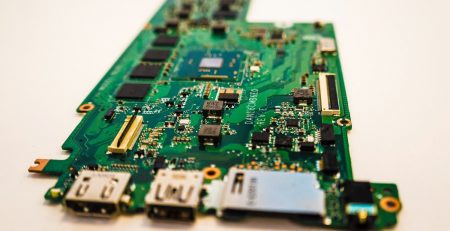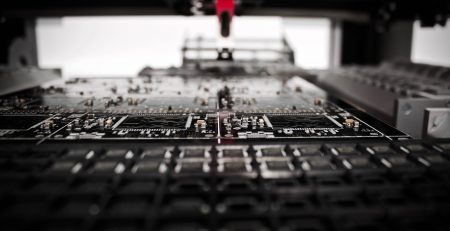Who is the winner: Surface-Mount Technology (SMT) or Plated Through-Hole Technology (THT)?
It is undeniably evident how tedious the task of developing a new PCB is. Especially, looking through tens or even hundreds of variants of a part and checking on the current stock, future availability, and replacement parts. However, it is important to take the most fundamental decision: Surface-mount technology (SMT) or Through-hole technology (THT)? How to decide? Well, let us first understand these mounting methods!
A modern PCBA design has two main techniques for mounting components onto a PCB: Through-Hole Mounting and Surface Mounting.
PLATED THROUGH-HOLE TECHNOLOGY (THT)
Through-hole technology is the method of mounting electronic components, involving the utilization of lead that are inserted through holes drilled into PCB. Furthermore, these leads are soldered to pads on the contrary sides either manually or by automated mounting equipment. These two methods are:
1. Wave Soldering: Wave soldering is a technique that involves the use of waves and molten solder to attach electrical components onto the PCB.
- Initially, Flux is applied on the bottom side of the circuit board.
- The machine essentially consists of a heated tank of solder which is maintained at the required temperature for the soldering process.
- A wave of solder is set up within this tank and the boards are passed over a pan of molten solder.
- A pump below produces an uprising almost like a wave of solder. The solder is at high temperature; its range varies depending on the solder form.
- The PCB is passed over the molten solder tank using a conveyer belt mechanism, and the components are soldered onto the board.
2. Hand Soldering: It is the oldest form of soldering. Hand soldering is done in low bulk quantity. Hand soldering involves using an iron, solder, soldering wick, and flux to attach components to a circuit board. Sometimes, PCBs that are rejected or defective are hands soldered to remove the defects. Most common in rework or repair jobs.
Applications of Through-Hole Technology
- This technology is exemplary for products demanding high reliability even under tough conditions such as high levels of environmental conditions, mechanical stress, high voltage/power, high temperature, etc.
- The through-hole technique is useful for testing and prototyping as leads can be easily adjusted & manually replaced which enables us to try various layouts.
- Large manufacturing units are also more likely to use Through-hole technology because the cost reduction factor is less of a concern.
SURFACE-MOUNT TECHNOLOGY (SMT)
SMT refers to the technology of mounting and soldering the electronic/electrical components directly on the surface of a PCB.
The assembly process: In this method, no holes in the PCB are needed. Surface mount devices (SMD)have flat co-planar tails or leads that allow the component to rest on a flat exposed pad on the PCB. The components are mounted on the PCB using Pick & Place machine. Solder paste is applied on the connection pads through a stencil to cover the exposed areas. After components are placed using Pick & Place Machine, PCBs are reflowed in a furnace to melt the solder paste. It then forms a connection in the electrical and mechanical components leading to PCB. Many PCB assembly companies in Gujarat provide world-class assembly solutions at budget-friendly prices.
Due to the absence of holes, the SMT components are often smaller than Through-hole ones. This allows for greater miniaturization of circuits and assemblies, with a higher circuit density, and thereby helps to scale back costs.
Applications of Surface Mount Technology
Nowadays, the majority of electronic hardware avail of the benefits of surface mount technology. It has become more dominant due to its cost-effectiveness process as compared to through-hole technology.
All electronic devices demand a revolution in terms of size and weight. The smaller, the lighter, the better! Smartphones, tablets, laptops, Internet of Things (IoT) devices, and other electronic products all typically utilize the surface mounting process. It may be brought into play in manufacturing telecom and communications equipment, medical devices, traffic and transportation components, lighting, industrial and commercial hardware, and more.
Cost benefits of SMD manufacturing:
- Faster device manufacturing thanks to the pick and place process
- Improved manufacturing quality through automated PCB assembly
- Elimination of contamination
DIFFERENCE BETWEEN SMT & THT:
|
SR. NO. |
COMPARISON ASPECTS | SMT |
THT |
|
1 |
Development Level | Prototyping or High-volume production |
Proof of concept or prototyping or Low-volume production |
|
2 |
Board Application | Low power | High power |
|
3 |
Manufacturing Cost | Less expensive at scale |
More expensive in general |
| 4 | Environment | May fail in high mechanical stress |
Good for high mechanical stress |
| 5 | Soldering Type | Reflow Soldering |
Wave Soldering |
WHAT SHOULD I PREFER FOR MY PROJECT?
To determine which process is right for assembling your components to your PCB, you need to consider few things to determine the answer:
- Type of project: Prototyping or Manufacturing
- PCB Product type
- Which sector will use the product?
- Cost
- Reliability needs
- Size requirements
- Component density
- Speed-to-market requirements
After considering all these factors, you may decide to go with THT, SMT, or a combination of both options depending on your precise needs.
PCBs that use a combination of both techniques may have:
- A mix of both technologies on one side of the board
- Through-hole technology on one side and surface mount on the other
- Through-hole technology on one side and surface mount technology on both sides
- Through-hole technology for external connection and surface mount technology for other connections
CONCLUSION
As the Electronics manufacturing industry grows with each new iteration of electronic devices, components continue to shrink. In turn, the PCB layout needs to take up a smaller footprint in the enclosed case, too.
As the market demanded smaller and compact products these days, the industry has made the electronic components smaller as well, such that the smallest size is the 0201 package which measures only 0.6mm x 0.30mm. These tiny components are unmanageable to be soldered manually. Thus, it becomes obvious that SMT is revolutionizing and one needs a professional EMS company that handles this technology with precision.
Through-hole technology (the use of THT components) remains popular among hardware electronics hobbyists and is additionally suitable for quick prototypes.






Leave a Reply